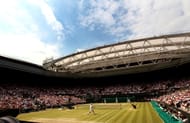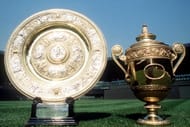The game of tennis returns to its most fierce battleground, the green-tinged courts of Wimbledon. This is where 'history has been made'; this is the true royal battleground where none but the best prevail.
Considered by tennis commentators and experts as the most prestigious Grand Slam of all, Wimbledon embodies the true enriching history of this game. A champion at Wimbledon, is a champion of the sport. A non-performer at Wimbledon can never be regarded a great of this sport - that's the prestigious accolade that Wimbledon holds with itself.
The inception of Wimbledon was in the year 1877 and since then it has been held at the All England tennis club every year. True to tennis’ name, Wimbledon was where the term “lawn tennis" was coined, and this is the only Major now that is still played on grass.
What makes Wimbledon distinct from the rest is the 'royalty' that it naturally comprises. From the compulsory white apparel of the players to the strawberries and cream eaten with relish by the spectators and royal patronage, the traditions at Wimbledon are time-honoured and well-preserved.
Courts: The most important court at Wimbledon tournament is Centre Court, where all the major matches take place. In 2009, to avoid the stoppage of the matches at the Centre Court due to rain delays, a retractable roof was installed which needs 20 minutes of opening/closing time, in case rain stops play.
Centre Court has a capacity of 15,000 and has a Royal Box at the South End, from where the members of the royal family and the dignitaries watch the proceedings.
After Centre Court is the Court No. 1, which holds withing itself the capacity to house 11,000 spectators. Further, in 2009, in place of the old Court No. 2, a new Court No. 2 was introduced which has a capacity of 4,000 people. The erstwhile Court No. 2 has been renamed as Court No. 3 and has 2,192 + 770 seats; this court is also referred to as the “graveyard of champions" because through the years, many greats of the game have been victims of shocking upsets on this court.
The giant television screen: At the northern end of the grounds there is a giant television screen which shows the most important match taking place. This area of grass is largely surrounded by the tennis fans throughout the 14 days of the tournament and is commonly referred to as “”Henman Hill” after the former British tennis player, Tim Henman.
Ball boys and girls: The ball boys and ball girls play a very critical role in the smooth running of the tournament. They are briefed about their job in these words – “you should not be seen, you should blend in with the background and get on with your job quietly”. It’s surely not an easy job but the ball boys and girls never fail to impress. They are also referred to as “BBG’s”.
Since 2005, the BBG’s work in a group of 6, and their roles are further classified into – two at the net, four at the corners and and two rotating in span of either 1 hour or 2 hours, depending upon the court.
In order to be selected as a ball boy or girl, the students are nominated first by their class teachers, and further they have to take a written examination test on the rules of tennis, after which there is the fitness test that comprises of physical, procedural and theoretical instructions.
The colour scheme of the tournament and uniform of players: Dark green and purple are the traditional colours of Wimbledon. The chair umpire, linesmen, ball boys and girls used to wear green clothing up until 2005/06, but this was changed and now the attire has been changed from to a navy blue and cream coloured uniform – these uniforms were desgined by Ralph Lauren, whose contract runs up to 2015.
The players are supposed to wear white clothing for the tournament. The clothing can have some colour accents but the primary colour of the uniform must be white – the long lived tradition at Wimbledon.
Royal Family: Till a few years back, if anyone from the Royal Family was present in the Royal Box, the players had to bow dow or curtsy to that person. In 2003 though, this rule was changed and since then the players are ONLY supposed to bow or curtsy to the Prince of Wales or her majesty The Queen.
Tickets for the tournament: The Centre Court and show court tickets have been sold to the general public since 1924 via a public ballot that the All England lawn tennis and corquet club holds at the start of every year.
Alongside this, the All England Lawn Tennis Club plc issues debentures to tennis fans every five years to raise funds for the capital expenditure. Fans who invest in the club are thus benefited and receive two tickets for every day of the championships.
Wimbledon and the French Open are the only Grand Slams where fans without tickets can queue up and still get seats on the three show courts on the day of the match.
The excitement for Wimbledon is unparalleled and hence some fans queue up on the last night of the matches itself, which The All England Club allows; in fact, they even provide toilet and water facilities to the campaigners. Those fans who queue up overnight are advised to bring tents and sleeping bags and if the campaigner succeeds in getting a ticket for the matches, his/her baggage (items that are not allowed inside the stadium) is kept safe with the club.
If people return early and hand over their tickets, these tickets are sold again and whatever money is earned from this sale - it is contributed to charity.
Trophies and prize money:
The gentleman’s singles champion receives a silver gilt cup which is 18.5 inches in height and 7.cm in width. This trophy is being handed over to the winner since 1887 and is incribed with the words “All England Lawn Tennis Club Single Handed Championship Of The World”.
The ladies’ singles champion receives a sterling silver salver known as the “Venus Rosewater Dish”. The salver is decorated with figures from mythology.
The winners of the gentlemen's doubles, ladies’ doubles and mixed doubles events receive silver cups. The runner-up in each of these events receives an inscribed silver plate.
The trophies are usually presented by the President of the All England Club, HRH Duke Of Kent.
Prize Money (singles):
| Winner | £1,600,000 | |
|---|---|---|
| Finalist | £800,000 | |
| Semi-finalists | £400,000 | |
| Quarter-finalists | £205,000 | |
| Fourth round losers | £105,000 | |
| Third round losers | £63,000 | |
| Second round losers | £38,000 | |
| First round losers | £23,500 |
|
(Courtesy – Wikipedia)
Ranking points:
| ATP | WTA | |
|---|---|---|
| First round | 10 | 10 |
| Second round | 45 | 70 |
| Third round | 90 | 130 |
| Fourth round | 180 | 240 |
| Quarter-finalist | 360 | 430 |
| Semi-finalist | 720 | 780 |
| Runner-up | 1200 | 1300 |
| Champion | 2000 | 2000 |
(Courtesy - Wikipedia)
Wimbledon 2014 – who are the defending champions?
The 2014 Wimbledon is just a few days away and the buzz surrounding the tournament has already begun. The players who will be sweating it out in the middle this year to defend their titles from last year are:
- Andy Murray – gentlemen’s singles
- Marion Bartoli – women’s singles (retired)
- Bryan Brothers – Gentlemen's Doubles
- Hsieh Wui and Peng Shuai – Womens' Doubles
- Daniel Nestor and Kritstina Mladenovic – Mixed Doubles
The excitement is at its peak! Which player are you supporting in this year's championships?


